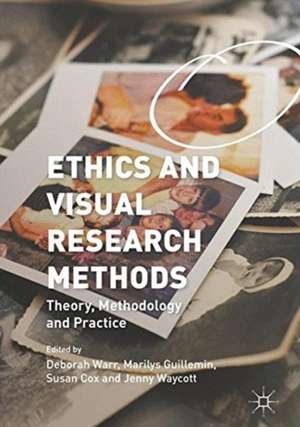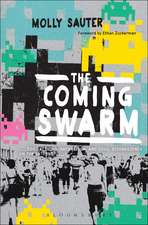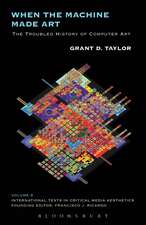Ethics and Visual Research Methods: Theory, Methodology, and Practice
Editat de Deborah Warr, Marilys Guillemin, Susan Cox, Jenny Waycotten Limba Engleză Paperback – 28 sep 2020
| Toate formatele și edițiile | Preț | Express |
|---|---|---|
| Paperback (1) | 690.66 lei 3-5 săpt. | +20.16 lei 7-13 zile |
| Palgrave Macmillan US – 28 sep 2020 | 690.66 lei 3-5 săpt. | +20.16 lei 7-13 zile |
| Hardback (1) | 877.53 lei 6-8 săpt. | |
| Palgrave Macmillan US – 27 dec 2016 | 877.53 lei 6-8 săpt. |
Preț: 690.66 lei
Preț vechi: 863.32 lei
-20% Nou
Puncte Express: 1036
Preț estimativ în valută:
132.17€ • 137.82$ • 109.85£
132.17€ • 137.82$ • 109.85£
Carte disponibilă
Livrare economică 27 februarie-13 martie
Livrare express 13-19 februarie pentru 30.15 lei
Preluare comenzi: 021 569.72.76
Specificații
ISBN-13: 9781349714773
ISBN-10: 1349714771
Pagini: 266
Ilustrații: XXI, 266 p. 6 illus., 5 illus. in color.
Dimensiuni: 148 x 210 x 19 mm
Greutate: 0.45 kg
Ediția:1st ed. 2016
Editura: Palgrave Macmillan US
Colecția Palgrave Macmillan
Locul publicării:New York, United States
ISBN-10: 1349714771
Pagini: 266
Ilustrații: XXI, 266 p. 6 illus., 5 illus. in color.
Dimensiuni: 148 x 210 x 19 mm
Greutate: 0.45 kg
Ediția:1st ed. 2016
Editura: Palgrave Macmillan US
Colecția Palgrave Macmillan
Locul publicării:New York, United States
Cuprins
INTRODUCTION.- Chapter 1 Ethical issues in visual research and the need for stories from the field - Deborah Warr, Jenny Waycott, Marilys Guillemin and Susan Cox.- PART 1 INTERSECTIONS: METHODS AND ETHICS.- Chapter 2 Different lenses: navigating ethics in cross-cultural research using Photovoice - Cathy Vaughan.- Chapter 3 Fuzzy boundaries in a project using ‘mental mapping’ methods to explore the experiences of immigrant women in South Korea - Hyunjoo Jung.- Chapter 4 Methodological and ethical concerns associated with digital ethnography in domestic environments: participant burden and burdensome technologies - Bjorn Nansen, Rowan Wilken, Jenny Kennedy, Michael Arnold and Martin Gibbs.- Chapter 5 The ethics of researching images found online - Anna Harris.- Chapter 6 Cultivating reflexive research practice when using participants’ photographs as research data - Carly Guest.- Chapter 7 The impact of photographs on the researcher: an ethical matter for visual research - KimMcLeod and Marilys Guillemin.- PART 2ETHICAL ISSUES IN CONTEXTS.- Chapter 8 Ethical considerations in the use of video observations in dementia end-of-life care research - Gloria Puurveen, Alice Phinney, Susan Cox and Barbara Purves.- Chapter 9 Towards an ecological approach to ethics in visual research methods with children - Philip Waters and Sue Waite.- Chapter 10 “I understand. I am a participant”: Navigating the ‘fuzzy’ boundaries of visual methods in qualitative longitudinal research - Geraldine Donoghue and Evonne Miller.- Chapter 11 Using visual research methods to explore first-person accounts of suicide trajectories - Jaime Roberto Fontbona and Deborah Warr.- Chapter 12 Conflicting aims and minimizing harm: uncovering experiences of trauma in digital storytelling about sexuality with young women - Aline Gubrium, Alice Fiddian-Green and Amy Hill.- Chapter 13 Ethical frameworks for digital storytelling with Aboriginal young people in southeast Australia - Fran Edmonds, Michelle Evans, Scott McQuire and Richard Chenhall.- PART 3 THE ETHICS OF RESEARCHING ART AND ARTFUL RESEARCH.- Chapter 14 Whither the aesthetic alibi: Ethics and the Challenge of Art as Research in the Academy - Barbara Bolt.- Chapter 15 Visually Embodying Psychosis: The Ethics of Performing Difficult Experiences - Katherine M. Boydell, Carmela Solimine and Siona Jackson.- Chapter 16 Exploring the Ethics of the Participant-Produced Archive: The Complexities of Dissemination - Casey Burkholder and Katie MacEntee.- Chapter 17 The politics of visibility, voice and anonymity: ethically disseminating visual research findings without the pictures - Dawn Mannay.- Chapter 18.Research by artists: integrating ethical frameworks - Lois Klassen.- Chapter 19 From Adversaries to Allies: Ethical Review in the Context of Visual and Other Innovative Methods - Susan Cox.
Notă biografică
Dr. Deborah Warr is Senior Research Fellow and Deputy Director, McCaughey VicHealth Community Wellbeing Unit, at the Centre for Health Equity, School of Population and Global Health, University of Melbourne, Australia. Her research addresses the circumstances of populations and communities vulnerable to experiencing forms of socioeconomic disadvantage and marginalisation.
Dr Marilys Guillemin is Professor, Centre for Health Equity, School of Population and Global Health, University of Melbourne, Australia. She has published widely in sociology of health and technology, visual and sensory methodologies, and ethical practice in research and health care.
Dr. Susan Cox is Associate Professor at the W. Maurice Young Centre for Applied Ethics and the School of Population and Public Health, at the University of British Columbia in Vancouver, Canada. She is an interdisciplinary qualitative health researcher with interests in the relationship between the arts and health, and is a member of the Advisory Board for the Arts Health Network Canada.
Dr Jenny Waycott is Lecturer at the Department of Computing and Information Systems at the University of Melbourne. Her research is mainly focused on human-computer interaction and educational technology.
Dr Marilys Guillemin is Professor, Centre for Health Equity, School of Population and Global Health, University of Melbourne, Australia. She has published widely in sociology of health and technology, visual and sensory methodologies, and ethical practice in research and health care.
Dr. Susan Cox is Associate Professor at the W. Maurice Young Centre for Applied Ethics and the School of Population and Public Health, at the University of British Columbia in Vancouver, Canada. She is an interdisciplinary qualitative health researcher with interests in the relationship between the arts and health, and is a member of the Advisory Board for the Arts Health Network Canada.
Dr Jenny Waycott is Lecturer at the Department of Computing and Information Systems at the University of Melbourne. Her research is mainly focused on human-computer interaction and educational technology.
Textul de pe ultima copertă
This collection presents stories from the field that were gathered from researchers using a breadth of visual methods. Visual methods refer to the use of still or moving images either as forms of data, to explore research topics and explorations of artistic practice. In addition to well-established visual methods, such as photo-voice and photo-elicitation, the possibilities for visual methods are flourishing through the proliferation of visual culture and developments in digital technologies. Methodological and ethical issues are emerging as visual methods are adapted and applied to answer new kinds of research questions, and in varied settings and populations. Authors offer practical and thoughtful discussions of emerging methodological and ethical dilemmas they encountered in innovative projects that used visual methods either in combination with other methods or as a stand-alone method. The discussions will be of interest to those seeking to understand the value, and potential ethical risks, of visual methodologies for social research.
Caracteristici
Addresses significant gaps in an expanding methodological field Offers in-depth and interconnected discussions of key theoretical, methodological and practical issues Presents an overview of key historical events in the development of research ethics and visual ethics










